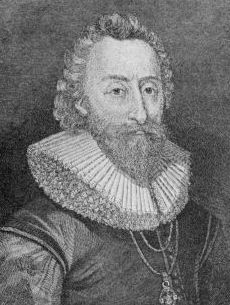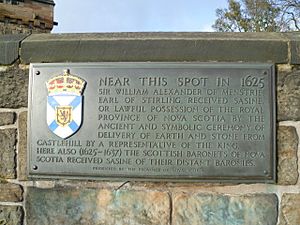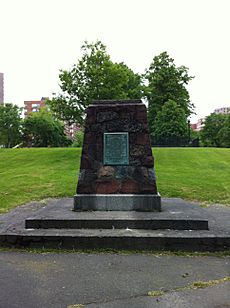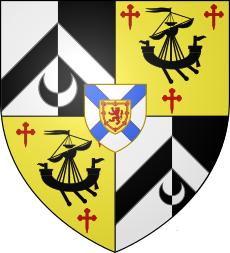William Alexander, 1st Earl of Stirling facts for kids
Quick facts for kids
The Earl of Stirling
|
|
|---|---|

William Alexander, 1st Earl of Stirling
|
|
| Secretary of State for Scotland | |
| In office 1626–1640 Serving with Sir Archibald Acheson
|
|
| Monarch | Charles I |
| Preceded by | The Earl of Haddington |
| Succeeded by | The Duke of Hamilton |
| Personal details | |
| Born |
William Alexander
1567 Menstrie Castle, Scotland |
| Died | 12 February 1640 London, England |
| Spouse | Janet Erskine |
| Parent | Alexander Alexander of Menstrie |
| Occupation | Politician |
William Alexander, 1st Earl of Stirling (born around 1567 in Menstrie, Clackmannanshire—died 12 February 1640) was an important Scottish figure. He was a Scottish courtier, a poet, and a key person in the Scottish efforts to create new settlements. He helped establish colonies in places like Charles Fort (now Nova Scotia) in 1629 and Long Island, New York.
His writings include poems and plays. Some of his famous works are Aurora (1604), The Monarchick Tragedies (1604), and Doomes-Day (1614, 1637).
Contents
William Alexander: A Scottish Pioneer
Early Life and Royal Connections
William Alexander was born at Menstrie Castle, near Stirling, Scotland. His father was Alexander of Menstrie, and his mother was Marion Couttie. When his father passed away in 1580, William was looked after by his great-uncle. He likely went to grammar school in Stirling. Some say he studied at the University of Glasgow and Leiden University.
As a young man, William became a tutor for the Earl of Argyll. He traveled with the Earl through France, Spain, and Italy. Before 1604, William married Janet Erskine.
Through the Earl of Argyll, William was introduced to King James VI's court in Edinburgh. He became known as a courtier-poet, meaning he was a poet who worked at the royal court. When King James VI became King of England in 1603, William moved to London with him. He became a Gentleman Usher for Prince Charles, King James's son. He remained a favorite at court even after Prince Charles became King Charles I in 1625.
William became a respected poet and writer of plays. He helped King James I and VI with a new version of the "Psalms of King David." In 1609, the King made him a knight. In 1614, he was appointed Master of Requests for Scotland. This role was like being the King's private secretary. He also became a member of the Scottish Privy Council in 1615.
Creating New Scotland: Nova Scotia


In 1621, King James I gave William Alexander a special document called a royal charter. This charter made him the leader of a huge area of land. This land was named Nova Scotia, which means 'New Scotland'. This area now includes Nova Scotia, New Brunswick, and parts of the northern United States. The King also created a new title, Baronets of Nova Scotia. This was a way to encourage people to settle in the new province.
In 1626, William Alexander became the Secretary of State for Scotland. He held this important job for the rest of his life. His efforts to create settlements were not very successful in terms of money. He made promises about the new land that were hard to keep. He did establish a Scottish settlement at Charles Fort in Nova Scotia. His son, William Alexander (the younger), led this settlement.
However, this effort cost William Alexander most of his money. In 1632, the region was given back to France. This meant the Scottish settlement was lost. Even with royal support, he could not get back the money he had lost. He spent his later years with little money. However, his efforts laid the groundwork for Scotland's claims to Nova Scotia. The Coat of arms of Nova Scotia and Flag of Nova Scotia used today come from his baronets.
Land in Long Island
In 1630, King Charles honored William Alexander for his service. He made him Lord Alexander of Tullibody and Viscount of Stirling. Three years later, in 1633, he became the Earl of Stirling and Viscount Canada.
On April 22, 1636, King Charles gave Long Island to William Alexander. The Plymouth Colony had claimed Long Island but had not settled it. William Alexander, through his agent James Farret, then sold most of the eastern part of Long Island to the New Haven Colony and Connecticut Colony.
In 1637, Farret went to New Amsterdam to claim English control. He was arrested by the Dutch but escaped. In 1640, English settlers tried to live at Cow Bay, now Port Washington. The Dutch arrested them, but released them after they said they were mistaken. After 1640, the eastern part of Long Island was quickly settled by the English. The western part remained under Dutch rule until 1674.
Later Life and Passing
William Alexander passed away in London on February 12, 1640. His grandson, William Alexander, became the 2nd Earl of Stirling. However, this young grandson also passed away in May 1640. The title then went to Henry Alexander, the 1st Earl's second son, who became the 3rd Earl.
William Alexander's Writings
William Alexander was a highly respected Scottish poet in the early 1600s. Many other famous writers praised his work. His first known work was Aurora (1604). This book contained poems he wrote when he was young.
He also wrote plays that were meant to be read, not acted on stage. These plays, like Croesus and Julius Caesar, were published together as The Monarchick Tragedies (1604). In these plays, he explored ideas about different types of government.
Alexander's biggest work was an epic poem called Doomes-day. It described the end of the world. It was first published in 1614 and later expanded in 1637. This long poem talks about world history and lists many different people and creatures who will appear at the Final Judgment.
He also worked with King James I on a new version of the Psalms. He wrote a continuation for Philip Sidney's famous story, The Countess of Pembroke's Arcadia. William Alexander also wrote down his thoughts on poetry in a work called Anacrisis (around 1635). In this work, he wrote about how much he enjoyed reading and writing. He saw his writing as a way to relax and get new ideas, separate from his busy life as a politician. The collected edition of his works was even titled Recreations with the Muses (1637).
Lasting Impact
The Canadian Coast Guard has named one of its ships, the CCGS Sir William Alexander, in his honor.


